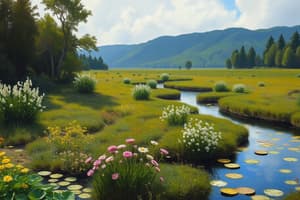Podcast
Questions and Answers
What are the two types of ecological succession identified by ecologists?
What are the two types of ecological succession identified by ecologists?
Primary succession and secondary succession
What is primary succession?
What is primary succession?
When new land is formed or bare rock is exposed, providing a habitat that can be colonized for the first time
What happens during primary succession?
What happens during primary succession?
Weathering and other natural forces break down the substrate, allowing pioneer species to establish and eventually be replaced by other species
What is secondary succession?
What is secondary succession?
Give an example of secondary succession.
Give an example of secondary succession.
What are pioneer species?
What are pioneer species?
What is a climax community?
What is a climax community?
Population Growth
Population Growth
The rise in human population leads to an increase in ______ emissions
The rise in human population leads to an increase in ______ emissions
Human activities lead to the ______ of habitats
Human activities lead to the ______ of habitats
The use of pesticides by farmers can pollute the ______ and nearby waterways
The use of pesticides by farmers can pollute the ______ and nearby waterways
Human impacts on the environment are not always _______
Human impacts on the environment are not always _______
The human population continues to ______ past 7 billion
The human population continues to ______ past 7 billion
Farmers use _______ that can seep into the soil and pollute it
Farmers use _______ that can seep into the soil and pollute it
Match the following terms with their definitions:
Match the following terms with their definitions:
Match the following environmental terms with their correct definitions:
Match the following environmental terms with their correct definitions:
Match these terms related to species and pollution with their definitions:
Match these terms related to species and pollution with their definitions:
Match the following ecological terms with their definitions:
Match the following ecological terms with their definitions:
Match these ecological phenomena with their descriptions:
Match these ecological phenomena with their descriptions:
Match these environmental terms with their meanings:
Match these environmental terms with their meanings:
Match the following environmental processes with their descriptions:
Match the following environmental processes with their descriptions:
Match the following terms with their definitions:
Match the following terms with their definitions:
Match the following ecological terms with their descriptions:
Match the following ecological terms with their descriptions:
Match the following ecological terms with their definitions:
Match the following ecological terms with their definitions:
Match these environmental phenomena with their descriptions:
Match these environmental phenomena with their descriptions:
Match these terms related to species and pollution with their definitions:
Match these terms related to species and pollution with their definitions:
Flashcards are hidden until you start studying
Study Notes
Ecological Succession
-
Two types of ecological succession are recognized: primary succession and secondary succession.
-
Primary succession is the gradual colonization of a barren, lifeless area by a series of organisms that change the environment over time.
-
Primary succession happens when new land is formed, such as from volcanic eruptions, retreating glaciers, or sand dunes.
-
Pioneer species, such as lichens and mosses, are the first organisms to colonize the barren land. They break down rocks, create soil, and make the environment more suitable for other organisms to thrive.
-
Secondary succession occurs when a previously existing community has been disrupted, for example, by fire, flood, or human activity.
-
Secondary succession starts with soil already present, allowing the process to occur more rapidly than primary succession.
-
A climax community is the final, stable community that develops after succession, characterized by a high diversity of species and a complex web of interactions.
Human Impact on the Environment
-
The rise in human population leads to an increase in greenhouse gas emissions.
-
Human activities lead to the fragmentation of habitats.
-
The use of pesticides by farmers can pollute the groundwater and nearby waterways.
-
Human impacts on the environment are not always reversible.
-
The human population continues to grow past 7 billion.
-
Farmers use fertilizers that can seep into the soil and pollute it.
Studying That Suits You
Use AI to generate personalized quizzes and flashcards to suit your learning preferences.




